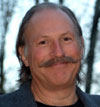These are facts. Problems arise only when we try to make sense of them altogether. Probably the best-known view is the Copenhagen Interpretation, which sprang mostly from the fertile minds of Heisenberg and Neils Bohr in the 1930s.
The idea goes like this: Every solid object is made of energy and has a wave nature. Small-particle waves are well understood, and their wave function collapses when they are disturbed. Only then can that particle actually exist in a specific spot. What makes a particle’s wave function collapse? To measure it, you have to hit it with something like light, and that instantly does the job. But these guys went further and said merely learning about the electron triggers the collapse. Knowledge alone collapses a wave function.
Wait, it gets worse. From there, it was only a short mad stroll to the increasingly accepted (but still minority) notion that no objective universe exists. Observations are the cosmos. Without your mind, things don’t exist — certainly not in their present forms.
Not happy with that? Then consider the most popular alternative, the Many Worlds Interpretation (MWI), accepted by such luminaries as Stephen Hawking. The MWI presumes countless realities in addition to the world we know.
Every time you make any choice in life, or perform any sort of experiment with more than one possible outcome, all outcomes occur, each in a different world. We are aware only of the world that contains the result we have seen.
The MWI avoids the “spooky action at a distance” of Copenhagen and reasserts “realism,” or an objective reality. Contradictions, superpositions, and wave-collapse choices vanish because only one outcome inhabits the world we know. You occupy one universe. Other universes exist in which another “you” who once toyed with the notion of studying art instead of law did, indeed, move to Tuscany and marry that girl you once met on a bus.
Today, MWI is widely embraced, but I suspect we might soon swing back toward Copenhagen because entangled-particle experiments support “non-locality.”
To understand this theory, we should reboard that carnival ride we took 2 years ago in “Theory chaotic” (July 2004). In brief, bits of light or matter get created at the same time and fly off in different directions. But they are entangled, meaning they share a wave function because of their simultaneous births. So, if one particle or photon is observed, measured, or interfered with in any way, its twin instantaneously knows this happened, and its own wave function collapses.
Result: If you measure a particle and learn it spins clockwise, its twin suddenly leaves its blurry “anything’s possible” reality and exhibits an opposite spin. This happens instantly, even if a billion light-years separate the pair. It also works with groups of particles. Objects aren’t independent of the rest of the universe, and quantum news travels infinitely faster than light. Wild stuff, and true: It’s been repeatedly confirmed since 1997.
Does this make your head spin? Maybe that’s why mine has started to spin, too, the opposite way.
But perhaps we needn’t even choose between Copenhagen and MWI. Maybe quantum’s paradoxes arise from some as-yet-undiscovered interaction between the experimental apparatus and the particles. Or unknown phenomena may be at play.
If we’re willing to say, “Maybe this theory is incomplete,” that might keep our head-spinning to a minimum, for now.
In the meantime, we can thank — or blame — Werner Heisenberg for appearing here in our world, rather than in next-door reality 8766.










